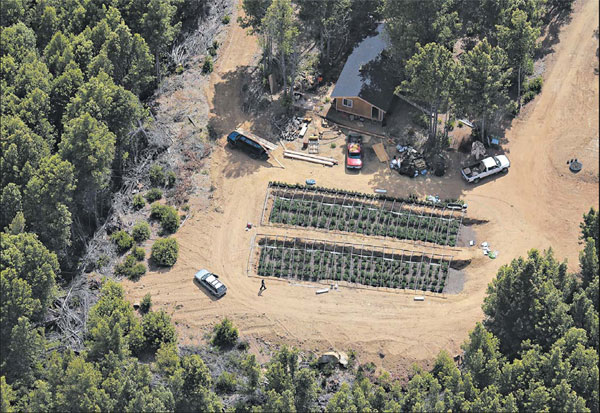Marijuana's pollution threat
Updated: 2013-07-14 08:05
By Felicity Barringer(The New York Times)
|
|||||||
|
Like the logging industry before it, the business of marijuana is a threat to the forests of California. A crop on private land in Humboldt County. Photographs by Jim Wilson / The New York Times |
|
While some farms dry up streams, this grower uses a rainwater pond. |
Arcata, California
It took the death of a small, rare member of the weasel family to focus the attention of Northern California's marijuana growers on the impact that their huge and expanding activities were having on the environment.
The animal, a Pacific fisher, had been poisoned by an anticoagulant in rat poisons like d-Con. Since then, six other poisoned fishers have been found. Two endangered spotted owls tested positive. Mourad W. Gabriel, a scientist at the University of California, Davis, concluded that the contamination began when marijuana growers in deep forests spread d-Con to protect their plants from wood rats.
That news has helped growers acknowledge, reluctantly, what their antagonists in law enforcement have long maintained: like industrial logging before it, the booming business of marijuana is a threat to forests whose looming dark redwoods preside over vibrant ecosystems.
Hilltops have been leveled to make room for the crop. Bulldozers start landslides on erosion-prone mountainsides. Road and dam construction clogs some streams with dislodged soil. Others are bled dry by diversions. Little water is left for salmon whose populations have been decimated by logging.
And local and state jurisdictions' ability to deal with the problem has been hobbled by, among other things, the drug's murky legal status. It is approved by the state for medical uses but is still illegal under United States law, leading to a patchwork of growers. Some operate within state rules, while others operate outside the law.
Scott Bauer of the California Department of Fish and Wildlife said, "I went out on a site yesterday where there was an active water diversion providing water to 15 different groups of people or individuals," many of them growers. "The stream is going to dry up this year."
Brad Job's territory as a United States Bureau of Land Management officer includes public lands favored, he said, by Mexican drug cartels whose environmental practices are the most destructive. "The watershed was already lying on the ground bleeding," Mr. Job said. "The people who divert water in the summer are kicking it in the stomach." That water is crucial to restoring local runs of imperiled Coho salmon, Chinook salmon and steelhead, which swam up Eel River tributaries by the thousands before the logging era.
Whatever its impact on the environment, marijuana is an economic staple, particularly in Humboldt County. Jennifer Budwig, the vice president of a local bank, estimated last year that marijuana infused more than $415 million into the county's annual economic activity, one-quarter of the total.
It is a thriving agribusiness. Derek Roy, with the National Marine Fisheries Service, said, "These grow sites continue to get larger and larger." Things took off after 1996, when California decriminalized the use of medical marijuana, Mr. Roy said.
The older farmers say that newcomers arrived eager to cash in, particularly in the past decade.
"There is a gold rush," Mr. Greacen said. "And it's a race to the bottom in terms of environmental impacts."
The worst damage is on public lands. There, plantings are surrounded by d-Con-laced tuna and sardine cans, Dr. Gabriel said. Mr. Job said these illegal operations have 70,000 to 100,000 plants; they are believed to be the work of Mexican drug cartels.
But small farmers have an impact, too. Mr. Bauer said that when he recently found the water diversion and asked those responsible about it, "these people we met with were pointing a finger all over the watershed, saying: 'We're not that big. There are bigger people out there.'"
Federal environmental agents, including Mr. Roy and Mr. Job, have brought two cases to the United States attorney's office in San Francisco. The office declined to prosecute a case last year, they said. A new one is under review.
Gary Graham Hughes of the Environmental Protection Information Center in Arcata, said growers were having an identity crisis. "The people who are really involved with this industry are trying to understand what their responsibilities are," he said.
The New York Times
|
Marijuana is approved by California for medical uses but is still illegal under federal law, a situation that has led to a patchwork of growers. Jim Wilson / The New York Times |
(China Daily 07/14/2013 page9)


